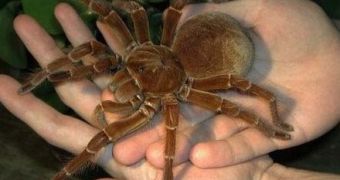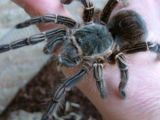1. Those large hairy spiders are called tarantulas. Their name comes from the port of Taranto (southern Italy). The locals correlated the convulsions and uncontrolled jumps of the victim of a tarantula bite to the local dance of tarantella, and hence the name of these spiders. Biologically, they are included in the family of Theraphoside and comprise about 800 species, found on all continents, except Antarctica.
2. These are by far the largest spiders. The largest species is the Goliath bird eater spider (Theraphosa blondi). It lives in the rain forests of South America; this tarantula has a leg span of up to a 30 cm (12 in) and can weigh up to 120 grams (as much as 2 mice). Most spiders weigh around 2 grams! And most other tarantulas around 7 grams. They are a deep burrowing species which is highly appreciated in the local cuisine. Tarantulas are also considered delicacies in many places of Africa and Asia (like Thailand). Australian Aborigines consider a delicacy Australia's largest spider, the barking spider (Selenocosmia crassipes), a tarantula.
3. Despite being so large, tarantulas do not make the list of the deadly spiders as their venom is weak. They frighten rather because of their huge fangs, 1-2.5 cm (0.4-1 in) long. The tarantula bite has been compared to that of a wasp. Spiders with lethal venom belong rather to other families and are much smaller than tarantulas, like the black widow spider. The so-called funnel web tarantulas (Atrax) from Australia, possessing a venom deadly for the people, are not proper tarantulas (they do not belong to the Theraphosidae family). Meanwhile, small spiders, like the Black Widow spider (Latrodectus) has a venom 15 times more powerful than that of the rattlesnake.
4. Tarantulas weave silk wens around their territories, which rather than catching the prey, serve to signal the presence of the prey. Long fibers transmit signals received by the sensory hairs on the feet of the tarantulas. These huge spiders have 8 eyes, but their visual acuity is weak. Silk is also used to protect their eggs and conceal their nests. The sticky silk on their feet is employed when walking on slippery vertical surfaces.
5. The hunting technique of the tarantula is to stay and wait inside their burrows and to attack rapidly when they detect the presence of the prey. Most of the prey of the tarantulas is made of crickets, beetles, locusts, butterflies and other spiders, but they can also eat small birds, mice, small snakes and amphibians. Like any spider, a tarantula cannot eat solid food. It must inject digestive juices into the prey, then it sucks the resulting "soup".
6. The longevity of the tarantulas goes up to 5-10 years. Quite long for a spider!
7. Like in other spiders, the female tarantula is likely to eat the male after mating. She lays about 2,000 eggs whose incubation lasts 1-3 months. Most of the young are consumed by predators in the first years of life. The most terrible enemy of the tarantulas is the tarantula hawk (Pepsis), a species of wasp. This insect paralyzes the huge spider, transport it to its own burrow and seals the entrance with a sail. The wasp lays its eggs into the body of the paralyzed tarantula, and the wasp larvae consume the tarantula while still alive! Many reptiles, birds and mammals (humans included, as already mentioned) indulge with tarantulas. Today, many tarantula species are menaced by agriculture, industry, deforestation, fires and overexploitation (for food or pet trade).

 14 DAY TRIAL //
14 DAY TRIAL // 
